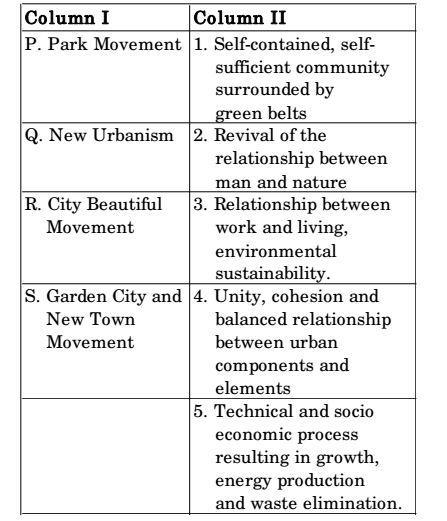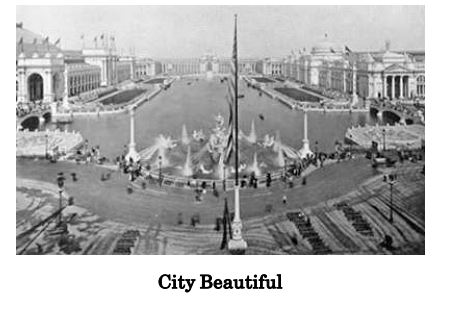-
Match the contemporary Urban Design Movements listed in Column I with the corresponding principles listed in column II and select the appropriate option,

-
- P-2, Q-3, R-4, S-1
- P-1, Q-5, R-3, S-2
- P-5, Q-3, R-1, S-2
- P-2, Q-5, R-4, S-1
Correct Option: A
The City Beautiful Movement (Daniel Burnham)
A transformation movement in North American architecture and urban planning that grew in 1890 and 1900. It incorporated Beaux-arts and Neoclassical architecture, and was shown in the World Columbian Exposition in Chicago. Burnham believed that a city needed a grand entrance and that was the railway depot. The Grand Boulevard was justified as a solution to traffic problems encounter ed by suburban commuters and a way to provide housing for higher income people in the city. Burnham also wanted all the bridges over the rivers rebuilt to be more attractive. The goal was to introduce beautification and monumental grandeur in cities. Daniel Burnham was involved in designing major r edevel opment schemes for the revision of L’Enfants plan of Washington DC in 1902, as well as Chicago in 1909. Both of which were exercises portrayed the principles of the City Beautiful while providing efficiency at a metropolitan scale. 
Ebenezer Howard (1850-1928) and the Garden City
In the early twentieth century, Britain’s Ebenezer Howard had a substantial influence on suburban planning. He aimed t o reduce the alienation of humans and society from nature and thus advocated Garden cities (planned, self contained communities surrounded by greenbelts containing proportionate areas of residences, industry and agriculture) and Georgism (economic value derived from land should belong equally to all members of society). The garden city movement was initiated in 1898. Howard’s 3 magnets diagram addressed the question “where will the people go?”, the choices being Town, Country or Town Country. Attractions of a town + Attractions of countryside = Garden city (to bring together economic advantages of town with clean lifestyle of countryside.
New Urbanism : In the 1990s, many planners adopted the goals of the ‘new urbanism’ or ‘neotraditional ’ planning as advocated by architects Peter Calthorpe and Andres Duany. New urbanists attempt to build new communities that are compact, walkable, and focused on community centers, reducing automobile dependence and reproducing many of the best features of early-twentieth-century neighborhoods and suburbs.
State Park Movement in America has been associated with the “ Victorian ‘aptitude for passionate reform.’” Population growth and urbanisation were the impetus’ behind the Park Movement. The increase in property values led people to live in crowded houses near to industrial centres the problem was compounded with poor sewage facilities. Park land became a premium. Parks were seen to be a tool to improve the moral condition of certain citizens. It was thought that parks could be a levelling ground where the working classes could learn from the upper classes. Essentially a phenomenon of the twentieth century, the pioneering state park movement has grown rapidly and innovatively to become one of the most important forces in the preservation of open spaces and the provision of public outdoor recreation in the country.

